

Lower the humidity in the house
Humidity can have a major impact on the indoor climate in the home. Good humidity prevents a musty smell in the house and ensures a healthy living environment for you and your family. A lot of moisture is produced in the house every day by cooking, showering, washing and breathing. If the moisture cannot find its way out, damp problems will arise within the home. This is accompanied by health problems. It is therefore very important that you keep a close eye on the humidity in the house.
The consequences of high humidity in the house
Humidity depends on a number of factors, such as air pressure and temperature. The ideal humidity in the house is between 40 and 60 percent. When it exceeds 60 percent, it is considered that there is a high humidity in the house . Too high humidity creates mould and bacteria in the house, which is very bad for your health. The health effects can cause bronchitis, asthma or increased risk of allergies, for example.
Common causes of high humidity
Damp problems arise from rising damp, condensation and / or leakage. Rising damp enters the house through foundations, crawl spaces and cavity walls. Condensation can mainly be seen on cold materials in the house- for example frames, walls, mirrors and windows. Moisture switches from vapor form to liquid droplets during condensation. For example, the water vapor that can be seen against a window is condensation. Humans’ living fluids also contribute to damp problems in the home. Cooking, washing, showering and breathing are examples of lifestyle damp. The points mentioned in combination with poor ventilation cause moisture problems in the house.
What can you do to lower the humidity
It is very important that the humidity in the house is stable. There are a number of things you can do to lower the humidity:
- Reduce damp in the house: Hang your wet laundry outside. When it rains, you can open a window in the room where the laundry dries. After showering, dry the shower cubicle and the surrounding walls with a cloth. Always try to switch on the extractor hood and put a lid on the pans while cooking. You can also keep humidity levels low by opening windows before creating peak moments, during them and after- for example, opening the window before showering, leaving it open while you shower, and leaving the window opened after showering to ensure that all the moisture created during showering escapes the property.
- Ventilate: Keep damp areas, such as bathrooms, kitchens and laundry rooms, dry. Open a window or use the ventilation fans.
- Windows open. Just opening a window provides fresh air. Do this several times a day, and at night. so that the air can flow through your home.
- Mechanical ventilation: If your home has mechanical ventilation, make sure to use it. Never turn it off. In winter it is also wise to leave the ventilation on, especially when heating. Heating moist air takes much more energy than heating dry air, when you ventilate you make sure that the moisture gets out and you heat dryer air.
Would you like to know more about lowering humidity?
Do you have questions about damp control or are you unclear about lowering the humidity in your home? Contact us directly by phone or request a free damp assessment! We are happy to give you professional advice.
Plan a free damp assessment
Feel free to contact us for a free damp assessment or advice from our moisture expert.


